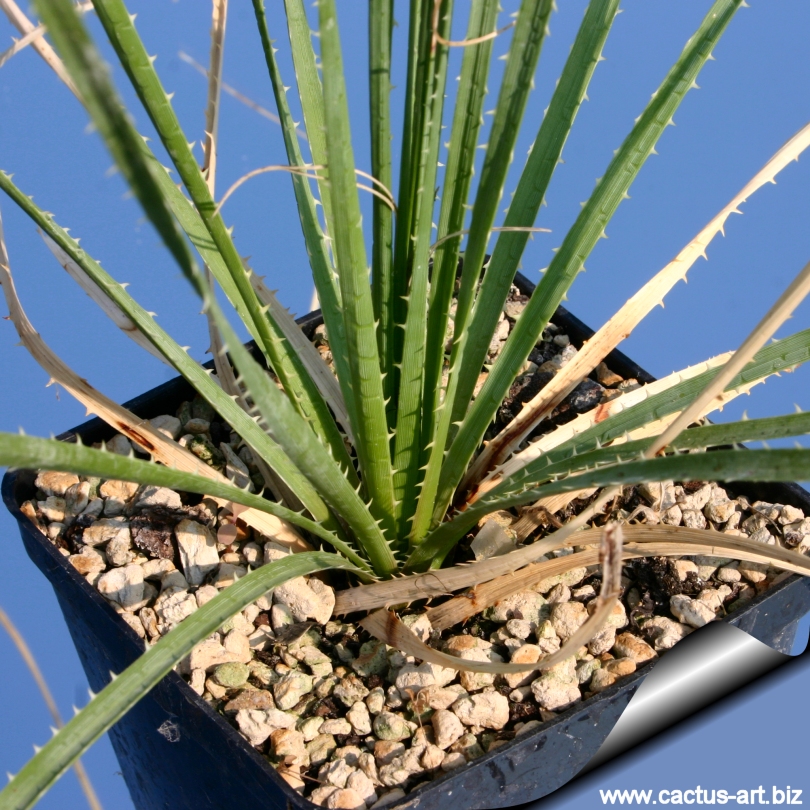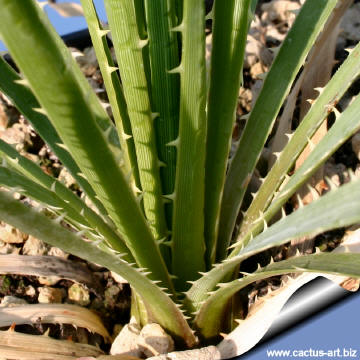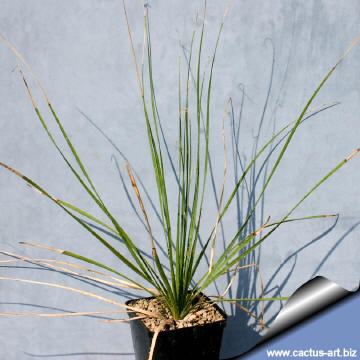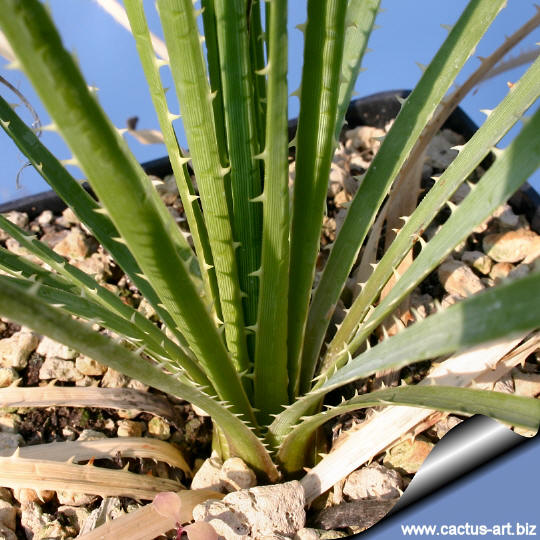|
|
|

Dasylirium cedrosanum
The rosettes are for many
years stem less, but old specimens may form a short, stocky trunk topped
by a spectacular, broom of countless leaves.
|
|
 |
 |
|
Cultivation: Dasylirions are slow growing,
not widely grown, carefree
and durable drought tolerant
plant.
They are said to
be quite hardy to both drought and severe freezes down to – 12° C and
although they prefer hot, dry climates, with excellent drainage and a
place in full sun they do admirably well even in cool, rainy conditions,
so worth trying if you have a sunny sheltered corner. As soon as the
soil drains well, they should be OK. Once planted in the ground they
never need additional water, though the odd deep watering during summer
would encourage more rapid growth
(don't water the crown, though they
rot easily). These make
great specimen plants for xeriscape gardens and
blend well in either tropical or arid
gardens. Small plants are relatively
inexpensive, but larger ones are a fortune. These make excellent potted
specimens, and their symmetrical form
provides a striking focal point. They thrive best in full sun, but can
be grown with some shade and humidity. Plant in very fast draining soil
and provide little or no water in winter. Treat like a succulent.
Plants in containers
can be moved inside during longer cold spells.
Cultural practises: Remove old boom stalk. No need other maintenance.
Propagation: Easy to propagate
from seeds or cuttings (If available).
|
|


Advertising
|
|
|
|
|
|
Family: Agavaceae (Agave
family) but it is now considered to be in the Nolinaceae
family (with Nolina and Beaucarnea)
Scientific name: Dasylirion
cedrosanum Trelease
In: Proc. Amer. Philos. Soc. 50: 431. 1911
Origin:
It is found on the Mexican highland in
the Sierra Madre Occidental and Sierra Madre Oriental (mainly in the
states of Chihuahua, Coahuila and Durango, it is also found - but rarer
- in the states of Nuevo León, Zacatecas and San Luis Potosí)
Habitat:
Grassland and open shrub-land (Desert Rosetophylous Matoral, Spiny
Crassifolious Mattoral and Pastizal) in the desert of chihuahua at 1000
to 2000 metres of altitude over sea level. It is typically found on
rocky or gravelly slopes on limestone rich soils
Common English Names include: Mexican Grass Tree,
Bear Grass, Sotol
Synonyms:
- Dasylirion
palmerii Trelease
- Dasilirion
stewartii I.M. Johnston
Etymology:
The genus name Dasylirion comes from the Greek word
“dasy” meaning “thick” or “dense”, and “lirion”,
“white lily”, alluding to the compact arrangement of flowers in the
inflorescence |
|
Description:
D. cedrosanum is a beautiful robust, perennial,
evergreen plant from Northern Mexico, similar to D. wheeleri
although the leaves may be slightly wider. The rosettes are for many
years stem less, but old specimens may form a short, stocky trunk topped
by a spectacular, broom of countless leaves and showing a graceful
symmetry. Sometime a plant has more than one trunk.
Withstanding intense drought, they can live
more than 150 years.
Stem: It forms a short, partially subterranean,
stocky, fibrous trunk covered by persistent leaves, 25 to 1,50 cm
tall with age. In many case a long broom of dead leaves helps prop up
the short trunks that tend to recline with age. The stem branches at the
base of the inflorescence and continues growing.
Root: Thick and fleshy spreading out from the thickened stem
base. The roots may be expendable in time of severe drought, the plant
sending uot new ones when condition improve.
Leaves: Numerous, radiating
symmetrically from the trunk,25
to 75 cm long-linear, borne upright, dropping or arching, relatively
broad (1,-2,5 cm wide), flexible, stiff, and spoon-shaped where they
attach to the trunk. They are glaucous-blue to glaucous-white,
and twisted typically. Small yellowish to brownish sharp,
marginal teeth pointing away from the leaf edges.
Older leaves droop around the base,
forming a shaggy mantle that collects water and provides support. But in
cultivation the bottom leaves can be trimmed exposing an ornamental
symmetrical spiral leaf-base pattern that never fails to attract
comments.
Inflorescence: Woody, narrow
and dense near the top of the plant, with small finger-like branches
called fascicles. Thousand of small insignificant, cream-coloured
flowers are borne on a single inflorescence with female and male flowers
on separated plants.
Blooming season: They
may go years without blooming, then send up the tall flower stalk in
May to
July.
Fruits: If successfully
fertilized, will produce a
yellow to
cream,
three winged
dry, indehiscent,
fruit on female
plant
where the flowers were earlier... this
all happens in the fall. Each
fruit bears only
one
(occasionally two) seeds. The wings maybe assists in wind dispersal of
the seed. |
|
|
|

|
|